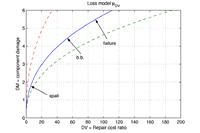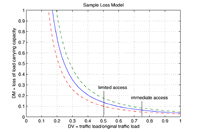| Project Title/ID Number |
Performance Assessment
of Highway Overpasses—5392003 |
| Start/End Dates |
10/1/03—9/30/04 |
| Project Leader |
Bozidar Stojadinovic (UCB/F) |
| Team Members |
Kevin Mackie (UCB/GS), Kyungkoo
Lee (UCB/GS), Meghann Rand (UCB/GS) |
F=faculty; GS=graduate student; US=undergraduate student; PD=post-doc; I=industrial
collaborator; O=other
Click on images to enlarge in a new window
1. Project Goals/Objectives:
The goal of this project is to provide the tools for performance assessment
of highway overpass bridges. Such tools enable assessment of bridge performance
in terms of the potential for bridge collapse in an earthquake, cost of
repair of such a bridge after an earthquake, and the ability of the bridge
to carry a given level of traffic load after an earthquake. The intended
users of such tools are bridge engineers and highway system maintenance
and emergency management professionals. Using these tools, the engineers
can assess the effect of different design decision on performance of the
overpass, while emergency management personnel can investigate potential
earthquake scenarios to plan for highway system emergencies before an earthquake
and obtain a quick estimate of potential bridge performance bottlenecks
immediately after an earthquake.
2.
Role of this project in supporting PEER’s mission
(vision):
The result of this project will benefit PEER industry partners involved
in bridge design and highway network maintenance and risk assessment
because it will give them a tool to estimate performance of highway overpass
bridges. This tool may be integrated into high-level applications that
assess the performance of highway networks enabling emergency scenario
planning and decision making at the level of an urban region.
3. Methodology Employed:
The tool for performance assessment of highway overpass bridges is base
directly on the PEER probabilistic performance-based design methodology
epitomized in the PEER total probability integral. The bridge performance-based
assessment tool is based on bridge fragility curves providing a total
probability of exceeding a chosen Damage Measure or Decision Variable
level.
4. Brief Description of past year’s accomplishments
(Year 6) & more detail on expected Year 7 accomplishments:
During Year 6 of this project we completed work on choosing optimal earthquake
Intensity Measures for highway overpass bridges. We also completed the probabilistic
demand models for typical highway overpass bridges (the IM-EDP relations)
with respect to a large number of bridge parameters, such as number of spans,
bridge aspect ratio, amount or reinforcement and abutment modeling. We also
incorporated the probabilistic damage models (EDP-DM) relations developed
by Professor Eberhardt for PEER http://nisee.berkeley.edu/spd/.
During
Year 7 we are developing direct and indirect loss models for bridges.
Direct loss models estimate the cost or repair of bridge components with
respect to the bridge replacement cost. Indirect loss models estimate
the
ability of a bridge to function after an earthquake in terms of its ability
to carry traffic and in terms of its remaining lateral and gravity load
strength. Sample direct and indirect loss model and resulting bridge fragility
curves are shown below.
 |
 |
| Fig 1 Sample component loss model |
Fig 2 Component level decision fragility |
 |
 |
| Fig 3 Sample bridge loss model |
Fig 4 Bridge level decision fragility |
5. Other Similar Work Being Conducted Within and Outside
PEER and How This Project Differs:
A major project on the development of a risk-based methodology for assessing
seismic performance of highway systems, conducted in cooperation between
MCEER and USC, is similar to this project. The differences are:
- The fragility curves developed in this project will be based on PEER
probabilistic performance-based methodology and developed using sophisticated
non-linear bridge computer models, while the USC/MCEER project uses simplified
bridge models or empirical fragility curves;
- USC/MCEER project
has a significantly wider aim; while this project
is focused on rational evaluation of bridge post-earthquake
operational state, repair time and cost, and aftershock collapse risk.
This project is vertically linked to PEER bridge test-bed projects: Humboldt
Bay Bridge, I-880 Bridge, and Bay Area Highway Network. Work on this project
depends on the results of several PEER projects. In particular, it is horizontally
linked to bridge component database projects (Eberhardt), OpenSees deteriorating
element development and validation projects (Mahin, Moehle, Lehman), and
fragility research (Project 304).
6. Plans for Year 8 if project is expected to be continued:
During Year 8 we plan to continue the project in two directions. First,
we plan to interact with PEER BIP to refine the assumptions on bridge direct
damage (repair costs) and indirect damage (traffic closures) related to
damage to bridge components including abutments and expansion joints. Second,
we plant to use a bridge testbed project to demonstrate the methodology,
and allow Caltrans engineers to evaluate how realistic the results really
are. Finally, we intend to put the produced DV fragility curves in a HAZUS-like
setting to prepare for data exchanges within the Tri-Center Project on Geographically
Distributed Systems.
7. Describe any actual instances where you are aware your
results have been used in industry:
At this time, the results of this project have not been used in practice.
Caltrans is continuously kept informed about the progress of this project
and is providing very useful feedback.
8. Expected Milestones & Deliverables:
The milestones for this project are:
-
Prepare a user interface enabling
users who are not experts in OpenSees to create a family of script files
to represent an array of typical overpass
bridges and subject them to a series of earthquake time-history analyses
to obtain the desired IM-EDP relations.
-
Enable users to vary bridge
parameters, such as bridge type, geometry, reinforcement and material,
as well as expansion joint and abutment models.
-
Identify already computed
IM-EDP relations from a stored database and use those instead of running
new analyses.
-
Link the IM-EDP relations to IM risk information provided
by other PEER projects.
-
Link the IM-EDP relations to EDP-DM performance
database provided by PEER.
-
Provide a tool for obtaining DM fragility
functions.
-
Link DM fragility functions to direct and indirect DM-DV relations.
Enable the user to specify parameters in DM-DV relations,
such as the estimated cost of repair or estimated cost of traffic
volume reduction.
-
Provide a tool for obtaining data on the probability
of exceeding a given level of DV value.
The deliverables of this project
are:
-
User interface software that integrates the IM-EDP-DM-DV
chain for performance assessment of overpass bridges
into one application.
-
Quarterly and annual repots.
-
Final project report.



